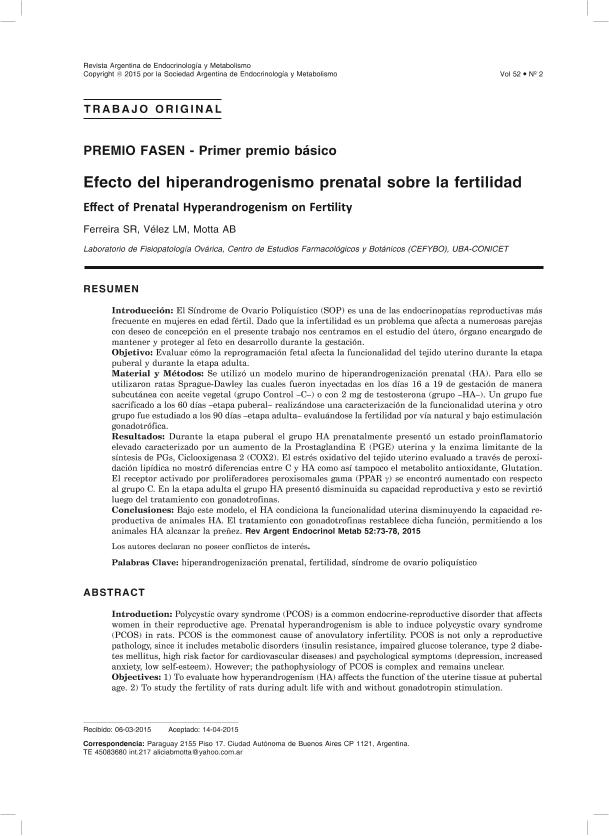Artículo
Introducción: El Síndrome de Ovario Poliquístico (SOP) es una de las endocrinopatías reproductivas más frecuente en mujeres en edad fértil. Dado que la infertilidad es un problema que afecta a numerosas parejas con deseo de concepción en el presente trabajo nos centramos en el estudio del útero, órgano encargado de mantener y proteger al feto en desarrollo durante la gestación. Objetivo: Evaluar cómo la reprogramación fetal afecta la funcionalidad del tejido uterino durante la etapa puberal y durante la etapa adulta. Material y Métodos: Se utilizó un modelo murino de hiperandrogenización prenatal (HA). Para ello se utilizaron ratas Sprague-Dawley las cuales fueron inyectadas en los días 16 a 19 de gestación de manera subcutánea con aceite vegetal (grupo Control -C-) o con 2 mg de testosterona (grupo -HA-). Un grupo fue sacrificado a los 60 días -etapa puberal- realizándose una caracterización de la funcionalidad uterina y otro grupo fue estudiado a los 90 días -etapa adulta- evaluándose la fertilidad por vía natural y bajo estimulación gonadotrófica. Resultados: Durante la etapa puberal el grupo HA prenatalmente presentó un estado proinflamatorio elevado caracterizado por un aumento de la Prostaglandina E (PGE) uterina y la enzima limitante de la síntesis de PGs, Ciclooxigenasa 2 (COX2). El estrés oxidativo del tejido uterino evaluado a través de peroxidación lipídica no mostró diferencias entre C y HA como así tampoco el metabolito antioxidante, Glutation. El receptor activado por proliferadores peroxisomales gama (PPAR γ) se encontró aumentado con respecto al grupo C. En la etapa adulta el grupo HA presentó disminuida su capacidad reproductiva y esto se revirtió luego del tratamiento con gonadotrofinas. Conclusiones: Bajo este modelo, el HA condiciona la funcionalidad uterina disminuyendo la capacidad reproductiva de animales HA. El tratamiento con gonadotrofinas restablece dicha función, permitiendo a los animales HA alcanzar la preñez. Introduction: Polycystic ovary syndrome (PCOS) is a common endocrine-reproductive disorder that affects women in their reproductive age. Prenatal hyperandrogenism is able to induce polycystic ovary syndrome (PCOS) in rats. PCOS is the commonest cause of anovulatory infertility. PCOS is not only a reproductive pathology, since it includes metabolic disorders (insulin resistance, impaired glucose tolerance, type 2 diabetes mellitus, high risk factor for cardiovascular diseases) and psychological symptoms (depression, increased anxiety, low self-esteem). However; the pathophysiology of PCOS is complex and remains unclear. Objectives: 1) To evaluate how hyperandrogenism (HA) affects the function of the uterine tissue at puber Pregnant Sprague-Dawley rats were prenatally injected daily with 2 mg free testosterone (HA group) or vehicle (Control group) from day 16 to day 19 of gestation. Female offspring were study at pubertal and adult age. The uterine oxidative stress was quantified by lipid peroxidation index (LP) and antioxidant glutathione (GSH) content. No differences were found between LP and GSH. The protein expressions of peroxisome proliferator-activated receptor gamma (PPAR γ), and the limiting enzyme of the PG synthesis, cyclooxygenase 2 (COX2) and the uterine PGE content increased in the HA group with respect to the C group. We also studied fertility at adult stage with and without hormone induction. The fertility rate decreased in HA. Hormone induction reversed the fertility rate similarly to controls. Conclusions: HA affects the uterine function in PCOS. HA increases protein levels of PPAR gamma, which modulates the pro-inflammatory status. The uterine oxidative stress was balanced. Fertility was decreased in the HA group and this was reversed by gonadotropin stimulation.
Efecto del hiperandrogenismo prenatal sobre la fertilidad
Título:
Effect of prenatal hyperandrogenism on fertility
Fecha de publicación:
07/2015
Editorial:
Sociedad Argentina de Endocrinología y Metabolismo
Revista:
Revista Argentina de Endocrinologia y Metabolismo
ISSN:
0080-2077
e-ISSN:
1851-3034
Idioma:
Español
Tipo de recurso:
Artículo publicado
Clasificación temática:
Resumen
Archivos asociados
Licencia
Identificadores
Colecciones
Articulos(CEFYBO)
Articulos de CENTRO DE ESTUDIOS FARMACOLOGICOS Y BOTANICOS
Articulos de CENTRO DE ESTUDIOS FARMACOLOGICOS Y BOTANICOS
Citación
Ferreira, Silvana Rocío ; Velez, Leandro Martin; Motta, Alicia Beatriz; Efecto del hiperandrogenismo prenatal sobre la fertilidad; Sociedad Argentina de Endocrinología y Metabolismo; Revista Argentina de Endocrinologia y Metabolismo; 52; 2; 7-2015; 73-78
Compartir




